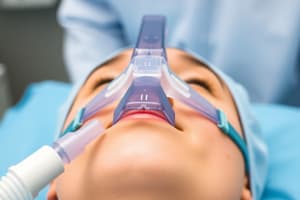Podcast
Questions and Answers
What does LMA stand for?
What does LMA stand for?
Laryngeal Mask Airway
The Laryngeal Mask Airway was invented in 1981.
The Laryngeal Mask Airway was invented in 1981.
True (A)
What is one advantage of using LMA over endotracheal tubes?
What is one advantage of using LMA over endotracheal tubes?
Less gastric distention
What year did the LMA gain FDA approval?
What year did the LMA gain FDA approval?
The LMA device is made of __________ material.
The LMA device is made of __________ material.
What is a primary use of the LMA?
What is a primary use of the LMA?
What is one limitation of the LMA?
What is one limitation of the LMA?
Which of the following are technologies that can assist in LMA insertion?
Which of the following are technologies that can assist in LMA insertion?
What shape is the silicone mask of the LMA?
What shape is the silicone mask of the LMA?
Flashcards are hidden until you start studying
Study Notes
Laryngeal Mask Airway
- The Laryngeal Mask Airway (LMA) is a supraglottic airway management device used for anesthesia and airway support therapy.
- It was invented by British Anesthesiologist Archie Brain in 1981.
- The LMA gained FDA approval in 1991.
- The LMA is a latex-free device and comprises an egg-shaped flattened mask, an inflatable cuff connected to an airway tube, a pilot tube which has a balloon situated on the tip to expand the cuff tube.
- The LMA is designed to fit in the hypopharynx of the patient's throat, isolating the trachea while covering the supraglottic makeup.
- The LMA aims to avoid any obstructions of the airway into the oropharynx by creating an air-tight seal across the larynx.
Advantages of LMA
- LMA is an alternative ventilation tool for operations rooms.
- It offers better haemodynamic stability than endotracheal tubes (ETT) and has an efficient emergent and enhanced recovery profile.
- LMA is a primary choice for difficult airway management in both hospital and out-of-hospital settings, compared to face-masks.
- Less risk of gastric distention than bag-valve-mask ventilation, reducing the risk of inspiration.
- LMA requires less training compared to other airway management techniques.
Disadvantages of LMA
- The LMA has limitations in providing proper support in cases where patients have beards or have facial substructures that do not facilitate the mask's fit.
- The LMA’s effectiveness is controversial for positive-pressure-ventilations (PPV) or spontaneous breathing patients after failed intubations, unresolved disgorgement effects, or any other complications.
LMA Complications
- Specific insertion methods, contraindications, complications, and misplacement issues are associated with the LMA use.
- The review article highlights complications related to its use during cardiopulmonary resuscitation (CPR) and general anesthesia.
- The article discusses advantages, disadvantages, complications, and contraindications of LMA use during maxillofacial or oral surgeries.
LMA Use
- The LMA can be inserted blindly or with assistance of other technologies (light-wand, fiber optics, and endoscopy).
- The review paper presents a comprehensive review of LMA devices, their advantages, disadvantages, complications, and contraindications.
Studying That Suits You
Use AI to generate personalized quizzes and flashcards to suit your learning preferences.




